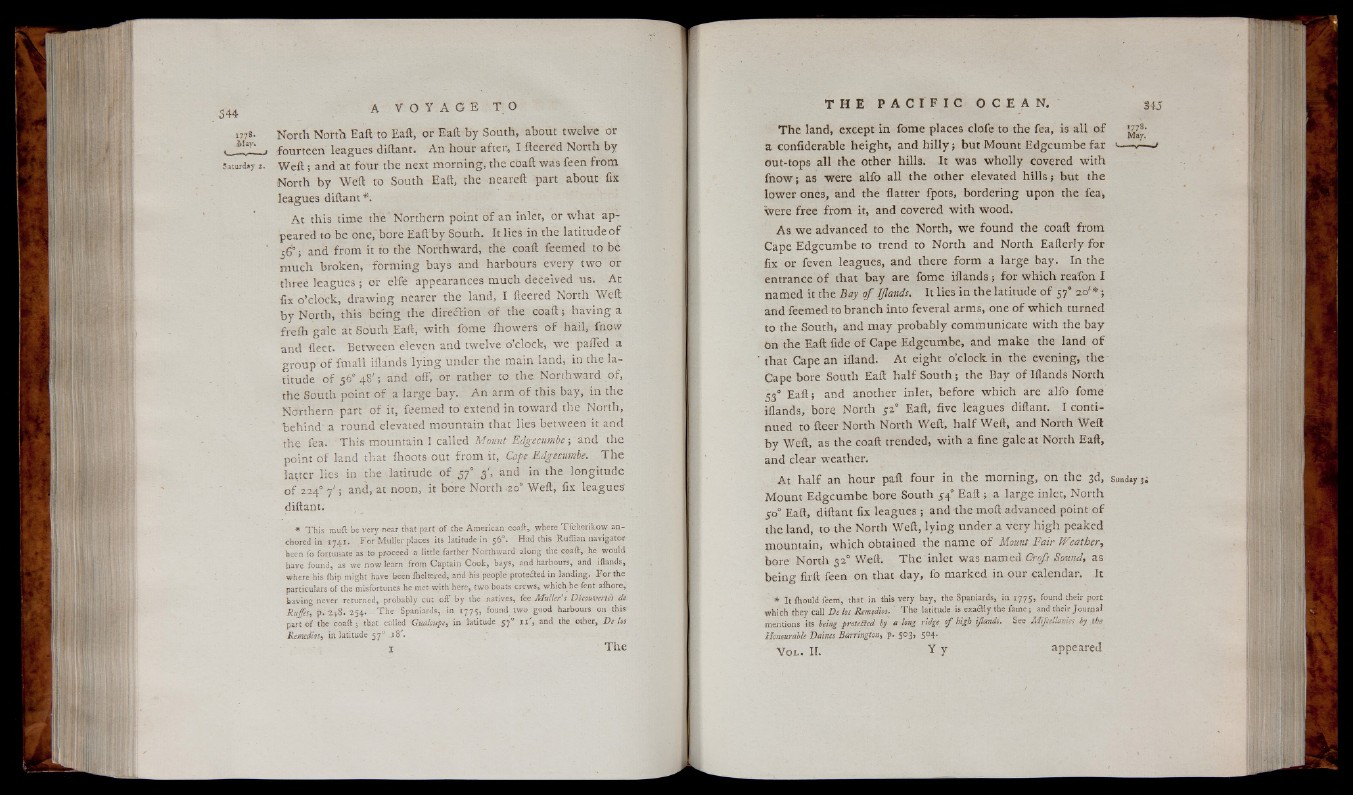
1 7 7 8 . North North Eait to Eaft, or Eaft by South, about twelve or
^ 1 -fourteen leagues diilant. An hour after, I fleered North by
S a tu rd a y 2. W e f t ; and at four the next morning, the coaft was feen from
North by Weft to South Eaft, the neareft part about fix
leagues diftant*.
A t this time the Northern point o f an inlet, or what appeared
to be one, bore Ea ftby South. It lies in the la titu d e o f
56°; and from it to the Northward, the coaft feemed to be
m u ch broken, fo rmin g bays and harbours every two or
three leagues ; or elfe appearances much deceived us. At
fix: o’ clock, drawing nearer the land, I fleered North Weft
by North, this be in g the diredtion o f the co a ft; ha vin g a
fre fh gale at South Eaft, w ith fome ihowers o f hail, fnow
and fleet. Between eleven and twelve o’clock, w e pafled a
group o f Small iflands ly in g under the main land, in the la titude
o f 56° 48'; and off, or rather to the Northward of,
the South point o f a large bay. An arm o f this bay, in the
Northern part o f it, feemed to extend in toward the North,
behind a round elevated mountain that lies between it and
the fea. This mountain I called Mount Edgecumbe; ' and the
point o f land that fhoots out from it, Cafe Edgecumbe. T h e
latter lies in the latitude o f 57° 3', and in the longitude
o f 224° 7 '; and, at noon, it bore North .20° Weft, fix leagues'
diftant.
* T h is muft be very near that part o f the American coaft, .where Tfeherikow anchored
in 1 7 4 1 . For Muller places its latitude in 56°. Had this Ruffian navigator
been fo fortunate as to proceed a little farther Northward along the coaft,, he would
have found, as we now learn from Captain Cook, bays, and harbours, and iflands,
where his Ihip might have been iheltered, and his people protected in landing. For the
particulars of the misfortunes he met-with here, two boats crews, which he lent aihore,
having never returned, probably cut o ff by the natives, iee Aduller s Decouvertes de
Ruffesi p. 24.8. 254. T h e Spaniards, in 17 75, found two good harbours on this
part o f the coaft j that called Gualoupe, in latitude 570 n , and the other, De los
Remedies, in latitude 5 70 j8 '.
1 The
T h e land, except in fome places clof<? to the fea, is all o f
a confiderable h e igh t, and h i l ly ; but Mount Edgcumbe far
out-tops a ll the other hills. It was w ho lly covered with
fn o w ; as were alfo all the other elevated h i l ls ; but the
lower ones, and the flatter fpots, bordering upon the fea,
were free from it, and covered w ith wood.
As w e advanced to the North, w e found the coaft from
Cape Edgcumbe to trend to North and North Eafterly for
fix or feven leagues, and there form a large bay. In the
entrance o f that bay are fome iflands ; for which reafon I
named it the Bay of IJlands. It lies in the latitude o f 57° 20' * ;
and feemed to branch into feveral arms, one o f which turned
to the South, and may probably communicate with the bay
On the Eaft fide o f Cape Edgcumbe, and make the land o f
that Cape an ifland. At eight o’clock in the evening, the
Cape bore South Eaft h a lf South; the Bay o f Iflands North
53° Eaft; and another inlet, before which are alfo fome
iflands, bore North 52° Eaft, five leagues diftant. I continued
to fleer North North Weft, h a lf Weft, and North Weft
b y Weft, as the coaft trended, with a fine gale at North Eaft,
and clear weather.
At h a lf an hour paft four in the morning, on the 3d, Sunday;,
Mount Edgcumbe bore South 54° Eaft ; a large inlet, North
5 0 ° Eaft, diftant fix leagues ; and the moft advanced point o f
the land, to the North Weft, ly in g under a very high peaked
mountain, w hich obtained the name o f Mount Fair Weather,
bore North 32° Weft. T h e inlet was named Crofs Sound, as
being firft feen on that day, fo marked in our calendar. It
* It fhould feem, that in this very bay, the Spaniards, in 17 7 5 , found their port
which they call De los Remedies. T h e latitude is exaffly the fame; and their Journal
mentions its being protected by a long ridge o f high iflands. See Mifcellanies by the
Honourable Daines Barrington, p. 5®3» 5®4*
V o l . II. Y y appeared.